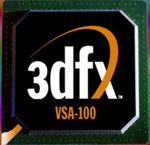 VSA-100
VSA-100
The VSA-100 is the first in a line of "Voodoo Scalable Architecture" chips and is the heart and soul of 3dfx’s Voodoo4 and Voodoo5 products. The word "Scalable" refers to the fact that multiple chips can be run in parallel, signifying the long awaited return of SLI to 3dfx's product line. There is support for up to 32-way SLI, which Quantum 3D will likely produce for extremely high-end applications. Each chip has its own 128-bit wide interface to memory, meaning that, unlike NVIDIA’s GeForce, the VSA-100 should not be limited by memory bandwidth. Although the memory is setup to be completely shared, texture data has to be repeated for each VSA-100 chip. This is typical of all current multi-chip solutions, such as 3dfx’s own Voodoo2 and ATI’s Rage Fury MAXX. However, the VSA-100 does have the advantage of FXT1/DXTC texture compression in hardware, which will minimize the amount of wasted space.
The SLI on the VSA-100 is actually a little bit different from the setup used on the Voodoo2 and is in fact quite a bit improved. The first change is that the number of scan lines that each chip renders can be adjusted from 1 to 128 lines depending on a number of factors, including number of chips, resolution, fillrate required, etc. This is something 3dfx will have to tweak for optimal performance. They have yet to determine whether this will be something fixed in the driver or if it will dynamically adjust depending on the load or the application involved. Since it is definitely software programmable, chances are that it will be a variable that end users will be able to tweak through the registry or any number of tweaking utilities.
The other big change is the SLI interface. On the Voodoo2, the interface was a multi-board, analog solution that required very strict timing control and identical boards. Furthermore, the analog signal was prone to degradation as it passed over a short cable inside the PC. VSA-100 features a 30-bit digital interface between the chips, which are all on one board this time. There are 28-bit data bits, a data valid bit, and a clock.
One advantage of the Voodoo2’s multi board SLI setup is that you could buy one Voodoo2 board to get started and add a second one at a later date to nearly double performance. Of course, this time that’s not possible as all chips must be on one board.
Compared to the Voodoo3, the VSA-100 adds support for 32-bit color rendering, 32-bit textures, 32/24-bit Z & W, and an 8-bit stencil buffer. Furthermore, the VSA-100 can also render two single-textured pixels per clock or one dual-textured pixel per clock. Support for 2048 x 2048 textures has now been implemented into the VSA-100, thus the VSA-100 offers essentially everything the Voodoo3 lacked and was criticized for tremendously.
The chip is an AGP 4X part, with support for AGP 2X, AGP 1X and PCI operating modes. In spite of this the VSA-100 does not support AGP texturing. 3dfx still feels that AGP texturing is not truly beneficial and thus there is no reason to pursue support for it with their products. The chip itself is composed of 14 million transistors, a little more than half the count of the original GeForce, and is manufactured on an enhanced 0.25-micron, 6-layer metal process. The "enhanced" 0.25-micron process just means that it takes advantage of shorter gate lengths, which allow for faster switching, thus allowing for higher frequencies and greater yields at those frequencies.
At the launch, 3dfx claimed that they would get better yields out of the tried and true 0.25 micron process than they would by moving to a 0.22 or 0.18 micron process like their competitors. Thanks to the long delays in getting the VSA-100 products to market, this strategy has more or less backfired on 3dfx, leaving them with a slower, hotter, more expensive chip. And to compound things, they're apparently not able to get enough chips out of their fab plant, TSMC in Taiwan, even though that's the same fab that NVIDIA uses.
The VSA-100 supports all T-Buffer effects, Full Screen Antialiasing, FXT1/DXTC texture compression and all of the other features 3dfx has been talking about for the past few months. For more information on those technologies read our in depth coverage of the T-Buffer here.
The VSA-100 supports anywhere from 4MB to 64MB of memory per chip, whose clock is synchronized with the core clock, just like the Voodoo3. The memory bus is 128-bits wide and will offer 2.7GB/s of memory bandwidth per chip. The excellent 350MHz RAMDAC of the Voodoo3 is carried over to the VSA-100, so 2D image quality is up there with the best.
From the above description the VSA-100 doesn’t appear to be much more than a Voodoo3 with support for a few new visual features and 32-bit color rendering support, but the chip’s support for up to 32-way SLI scalability (hence the name Voodoo Scalable Architecture) is what truly defines it and sets it apart from the Voodoo3.










1 Comments
View All Comments